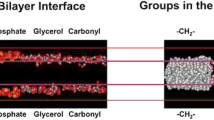Abstract
The intensity of the line of antisymmetric vibrations of CH2 in the Raman spectrum of molecular layers of fatty acids and phospholipids is sensitive both to the molecular order in the layer (lateral order) and to the conformational order of the hydrocarbon chain of the molecule. Though the intensity of this line is widely used as an indicator of order in molecular layers containing hydrocarbon tails, the nature of sensitivity of the line of antisymmetric vibrations to the order is still disputable. This issue has been experimentally studied, and it has been demonstrated that disordering leads to redistribution of vibrational modes and to changes in polarizability of antisymmetric vibrations. A hypothesis is proposed that the intensity of the line of the Raman scattering of antisymmetric vibrations of CH2 is determined to a large extent by their interaction with electron excitation of the hydrocarbon chain.
Similar content being viewed by others
References
N. V. Surovtsev, N. V. Ivanisenko, K. Y. Kirillov, and S. A. Dzuba, “Low-Temperature Dynamical and Structural Properties of Saturated and Monounsaturated Phospholipids Bilayers Revealed by Raman and Spin-Label EPR Spectroscopy,” J. Phys. Chem. B 116 (28), 8139–8144 (2012).
B. P. Gaber and W. L. Peticolas, “On the Quantitative Interpretation of Biomembrane Structure by Raman Spectroscopy,” Biochim. Biophys. Acta 2 (465), 260–274 (1977).
N. Yellin and I. W. Levin, “Hydrocarbon Chain Disorder in Lipid Bilayers: Temperature Dependence Raman Spectra of 1,2-Diacyl Phosphatidylcholine-Water Gels,” Biochim. Biophys. Acta 2 (489), 177–190 (1977).
R. Gharib, L. Auezova, C. Charcosset, and H. Greige-Gerges, “Effect of a Series of Essential Oil Molecules on DPPC Membrane Fluidity: A Biophysical Study,” J. Iran. Chem. Soc. 15 (1), 75–84 (2018).
D. A. Bryce, J. P. Kitt, and J. M. Harris, “Confocal-Raman Microscopy Characterization of Supported Phospholipids Bilayers Deposited on the Interior Surfaces of Chromatographic Silica,” J. Am. Chem. Soc. 140 (11), 4071–4078 (2018).
J. M. Arias, M. E. Tuttolomondo, S. B. Diaz, and A. B. Altabef, “Molecular View of the Structural Reorganization ofWater in DPPC Multilamellar Membranes Induced by L-Cysteine Methyl Ester,” J. Mol. Struct. 1156, 360–368 (2018).
P. Chatzigeorgiou, A. Mourelatou, E. Pollatos, et al., “Comparison of the Thermal Behavior and Conformational Changes in Partially and Fully Hydrated Dipalmitoylphosphatidylcholine Systems,” J. Therm. Anal. Calorimetry 131 (2), 887–898 (2018).
R. G. Snyder, S. L. Hsu, and S. Krimm, “Vibrational Spectra in the C—H Stretching Region and the Structure of the Polymethylene Chain,” Spectrochim. Acta A 34 (4), 395–406 (1978).
R. G. Snyder and J. R. Scherer, “Band Structure in the C—H Stretching Region of the Raman Spectrum of the Extended Polymethylene Chain: Influence of Fermi Resonance,” J. Chem. Phys. 71 (8), 3221–3228 (1979).
B. P. Gaber, P. Yager, and W. I. Peticolas, “Deuterated Phospholipids as Nonperturbing Components for Raman Studies of Biomembranes,” Biophys. J. 22 (2), 191–207 (1978).
L. Ricard, S. Abbate, and G. Zerbi, “Conformationally Dependent Fermi Resonances and Long-Range Interaction between σ Bonds in Polymethylene Systems Derived from their Raman Spectra,” J. Phys. Chem. 89 (22), 4793–4799 (1985).
L. Collard, D. Perez-Guaita, B. H. Faraj, et al., “Light Scattering by Optically-Trapped Vesicles Affords Unprecedented Temporal Resolution of Lipid-Raft Dynamics,” Sci. Rep. 7, 8589 (2017)
A. A. Dmitriev and N. V. Surovtsev, “Temperature-Dependent Hydrocarbon Chain Disorder in Phosphatidylcholine Bilayers Studied by Raman Spectroscopy,” J. Phys. Chem. B 119 (51), 15613–15622 (2015).
N. V. Surovtsev, “Suppression of Spurious Background in Low-Frequency Raman Spectroscopy,” Avtometriya 53 (3), 58–63 (2017) [Optoelectron., Instrum. Data Process. 53 (3), 250–254 (2017)].
N. V. Surovtsev and S. A. Dzuba, “Conformational Changes of Lipids in Bilayers at the Dynamical Transition near 200 K Seen by Raman Scattering,” J. Phys. Chem. B 113 (47), 15558–15562 (2009).
Author information
Authors and Affiliations
Corresponding author
Additional information
Original Russian Text © S.V. Adishchev, T.A. Duda, Yu.V. Zaitseva, V.A. Zykova, A.G. Milekhin, K.A. Okotrub, N.V. Surovtsev, 2018, published in Avtometriya, 2018, Vol. 54, No. 6, pp. 12–20.
About this article
Cite this article
Adishchev, S.V., Duda, T.A., Zaitseva, Y.V. et al. Stretch Vibrations of CH2 as a Measure of Conformational and Lateral Orders in Fatty Acid and Phospholipid Layers. Optoelectron.Instrument.Proc. 54, 538–545 (2018). https://doi.org/10.3103/S875669901806002X
Received:
Published:
Issue Date:
DOI: https://doi.org/10.3103/S875669901806002X




